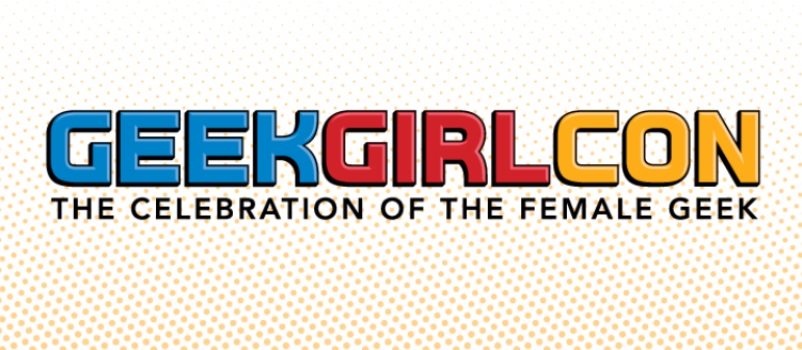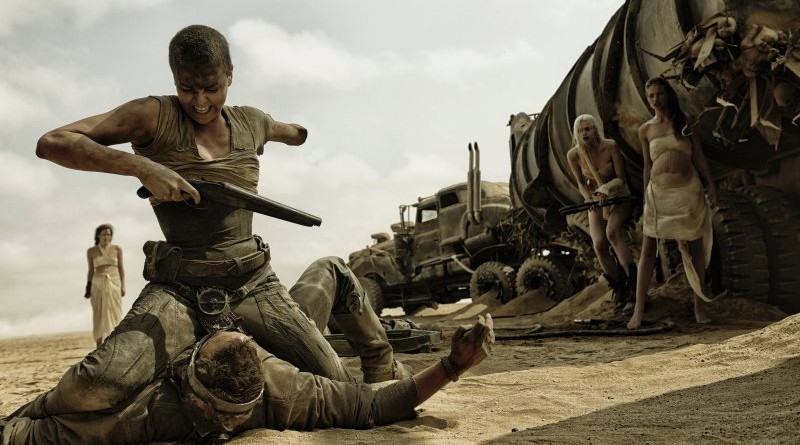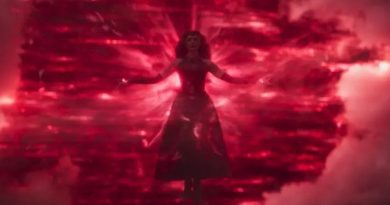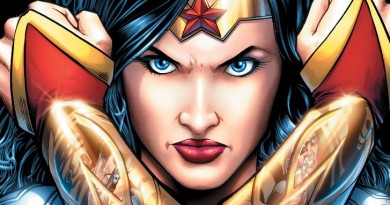GeekGirlCon 2015: Heroine’s Journey Panel Recap
 After last year’s highly successful, standing-room-only Heroine’s Journey panel at GeekGirlCon, our four panelists – B.J. Priester, Tricia Barr, Jennifer K. Stuller, and Alan Kistler – reconvened this year. Once again the room filled to capacity for another great discussion of female characters and their increasingly prominent role in fiction.
After last year’s highly successful, standing-room-only Heroine’s Journey panel at GeekGirlCon, our four panelists – B.J. Priester, Tricia Barr, Jennifer K. Stuller, and Alan Kistler – reconvened this year. Once again the room filled to capacity for another great discussion of female characters and their increasingly prominent role in fiction.
One of the best ways to help support the creation of more good stories with impactful female characters is to point out the successful, well-crafted tales when we see them. This includes both positive word of mouth, including actively on social media, as well as voting with our dollars to bolster the profitability of the stories we want to see more of.
In the movie arena, the box office smash Mad Max Fury Road not only starred Charlize Theron as the lead character but made over $150 million domestic. Although Jen noted that some feminists and critics have concerns about various aspects of the film, as discussed in a panel she moderated on Sunday at the convention, she praised its cast with numerous well-written female characters.
“There were just so many women in this movie. You had young women, you had middle-aged women, you had a forty-year-old actress – who is gorgeous and a model – cast as the lead in an action movie. … To be able to see so many women in the film was spectacular. And they all had their own characterizations; they weren’t just there as spectacle. … They had unique personalities, unique characterizations. They collaborated, they worked together. Collaboration, working together – women together, and with men – is a huge part of the female Hero’s Journey for me.”
~ Jennifer K. Stuller
From television, the panelists praised the recently concluded animated series The Legend of Korra. In addition to a lead female protagonist who undergoes a Heroine’s Journey with many familiar story beats, the show also featured an ensemble cast with filled with great characters and incredible diversity.
“The wonderful thing about Korra to me was how not just flawed she was, but really about being her. The first line she gives is, “Deal with it!” This is who I am. That’s amazing. It’s funny, but it’s also great to see that when there are so many Hero’s Journeys where they don’t know who they are until the very end. Korra knows who she is. The challenge for her is that she changes that idea. That’s a very adult story.”
~ Alan Kistler
Alan also pointed out that Korra’s villains each had legitimate grievances, though they pursued them in horrible ways, requiring the Avatar to approach resolving the conflicts with compassion and understanding reminiscent of original Wonder Woman. Tricia mentioned the show’s emphasis on Team Avatar and Korra’s cooperation with her friends and allies to achieve her objectives. Like Team Katniss in The Hunger Games, some romantic elements are included in the story, but not as the core of it. I remarked on how the show portrays Korra’s interaction with Tenzin changing the mentor figure’s own character arc, a dynamic not often seen in heroic journey stories. Later in the day, the panel “We’re the Avatar: Deal With It!” featured a great interactive discussion where fans, women and men alike, praised the show’s characters, storytelling, and representation.
In the world of comics, I recommended the Heroine’s Journey evolving for Kamala Khan in Ms. Marvel by G. Willow Wilson, who joined the convention on Sunday for a great panel discussion about women in comics and a signing with fans. Beyond elements similar to the classical heroic model, her story also includes many similarities to the Peter Parker origin story in the original Spider-Man comics. For instance, she is a high school who attains sudden superpowers, then struggles with the secrecy and guilt of hiding the truth from her family.
“What I really like about Ms. Marvel is that it’s taking her through a lot of the beats of the Heroine’s Journey. She gets her call to adventure. Then the first time she goes out to fight somebody she’s like, ‘Oh, I’ve got powers now, I can fight somebody!’ and she gets her butt kicked because she doesn’t know what she’s doing. What I also love about it is that it’s so contemporary. She’s a fangirl. In the first issue she’s writing fanfic about the Avengers. … It’s really a neat dynamic to see a very contemporary story with so many of these older elements, both from comics and from the Hero’s Journey.”
~ B.J. Priester
Importantly, Ms. Marvel illustrates not only the power of fans supporting a favorite character, both vocally and financially, but also the changing demographics of the customer base capable of creating a broad base of support for a character. A series that originally faced an uncertain future became a top-selling title for Marvel, particularly digitally, and now Kamala will be a member of the newly constituted Avengers team in the latest relaunch. Jen commented that we haven’t seen many wish-fulfillment stories for female characters, compared to the vast number written for male leads, which gives Kamala’s fangirl excitement at joining the Avengers even more resonance. Alan praised the idea that Kamala’s powers are not part of a lineage or career-based legacy from her family, but rather she simply is an Inhuman like many other individuals.
“She got these abilities. She could have chosen to not do anything, to keep them secret or go off and live, as many Inhumans do, in their weird city and just chill out. Instead she chooses to become a hero. Choice is such a wonderful symbol of what heroism is.”
~ Alan Kistler
Following up on that point, Tricia noted that creators sometimes fail to realize that they have other options as storyteller than simply the familiar dynamics like a bloodline or parental inspiration. It’s not necessarily a bad idea to use the trope of a character having a preordained destiny, but is it being used because it works best for the particular story being told, or merely repeating a commonly used element reflexively? Tropes that hinder female characters often appear when storytellers are reproducing the familiar wheel rather than telling new stories creatively.
“One of the things about the Hero’s Journey developing into the Heroine’s Journey is that we don’t want to look back at stories. We want to look at how we can evolve stories, and how you can make them different. Those are the stories that capture people’s imaginations, where you take something really familiar and you twist it.”
~ Tricia Barr
One example of a new kind of story that also includes numerous great female characters is the BBC television series Orphan Black. Like Fury Road, Jen emphasized the wide variety of women included in the story, and not only the many different clones played by Tatiana Maslany. The series also includes the search for the mother, a story element that remains rare even in Heroine’s Journey stories.
“We’re starting to see a lot more of these hero stories with women where you’re seeing women working together, helping each other out, having each other’s backs. Orphan Black is one, Lost Girl is another, Fury Road. I have hope for Supergirl. The pilot … was really good. I would like to see a non-white female hero on television, but it also looked like there were opportunities for women to be working together.”
~ Jennifer K. Stuller
On October 24, the new series Supergirl premieres on CBS, although the pilot episode has been made available for early viewing. Tricia agreed that the pilot looks promising. Alan emphasized an important aspect of the writing in the pilot: all of the major conversations Kara has about her life’s direction and philosophy occur with other women, including her sister, a message from mother, and her female boss. The panelists hoped the rest of the episodes live up to the strong example set by the pilot.
Despite some of the positive changes occurring in storytelling, significant issues remain to be addressed. Jen called out the continuing use of gendered terminology in relation to heroic characters. For example, Bravo’s three-part series in 2005 were titled “Ultimate Super Heroes,” “Ultimate Super Villains,” and “Ultimate Super Vixens.” Worse, a female character like Buffy Summers was included on the vixen list, rather than listed among the heroes. Using labels like vixen or minx to signify women and girls perpetuates the negative gendered connotations those terms carry, and diminishes the female characters.
“There’s a Nerf gun that’s aimed for girls called Rebelle. The word has no gender! Leia was not a rebelle!”
~ Alan Kistler
Because of these kinds of persisting problems, an important part of engaging in fandom is working to effectively criticize stories we love when they fall short. The panel mentioned some of the instances of female characters whose portrayals we wished would have done better, including Felicity Smoak on Arrow, Iris West and other women on The Flash, and the ending to Asajj Ventress’ story arc in the novel Star Wars: Dark Disciple. One common flaw in these stories in when writers limit themselves to using standard tropes, which can produce repeating messages that reinforce negative stereotypes about women and female characters. Even in franchises which deserve much positive praise, room for improvement can still exist. Jen expressed her wish that more people of color had been included in Fury Road, and that the Agent Carter cast had included more women.
Black Widow in Avengers: Age of Ultron provided a good illustration of a female character with both positives and negatives in her portrayal. The panelists agreed that Natasha’s conversation with Bruce about her infertility could have been written and edited in a much better way than it comes across in the final film. Alan offered the reminder that unintentional sexism is still sexism, and believed the film needed more conversation on their relationship to make the controversial scene more credible for the audience. Jen explained that Natasha’s agency was taken out of equation.
“You can tell what people’s priorities are by what corners they’ll cut, or by what they instinctively decide to remove or lessen.”
~ Alan Kistler
A problem that often dovetails with storytelling flaws is merchandise. Jen noted that this has been particularly noticeable with Marvel’s comic book movies, where the existence of merchandise without key characters like Black Widow and Gamora led to online campaigns such as #WeWantWidow and #WhereIsGamora hashtag campaigns. Tricia wondered if the situation will improve now that Kevin Feige has been able to remove Marvel Studios from under the umbrella of Ike Perlmutter’s influence on the overall Marvel brand.
“We would love to see Black Widow on merchandise. Why is she absent from the team? Why is Gamora absent from the team? Why are there no action figures; why aren’t there female-cut t-shirts? … You see the lone female team member absent. Which suggests, one, she’s not important, and two, little boys aren’t going to want to wear something with a cootie girl on it or play with a cootie girl toy. … It’s sending message about gender.”
~ Jennifer K. Stuller
Tricia also noted that the Disney Store’s costumes are listed as genderless this Halloween, simply for kids rather than boys or girls. Jen noticed lots of Black Widow merchandise available at the Disney Store in Paris.
To conclude the panel, we shared other stories with well-crafted female characters. B.J. is starting to read the Spider-Gwen comic, while Tricia mentioned Star Wars: Lost Stars by Claudia Gray and Uprooted by Naomi Novik. Jen is really looking forward to seeing Scully in action on the revived X-Files limited series, while Alan is anticipating Jessica Jones and Supergirl.
- BJ Priester Talks The Acolyte Episode 6 on Who’s the Bossk? - July 7, 2024
- Dave Filoni Talks Writing AHSOKA and Guiding the Future of Star Wars Storytelling - June 21, 2024
- Lessons in Franchise Management – MCU: The Reign of Marvel Studios - January 14, 2024











Pingback:Infertility Blog 2015 Wordpress Halloween | Infertility Benefits